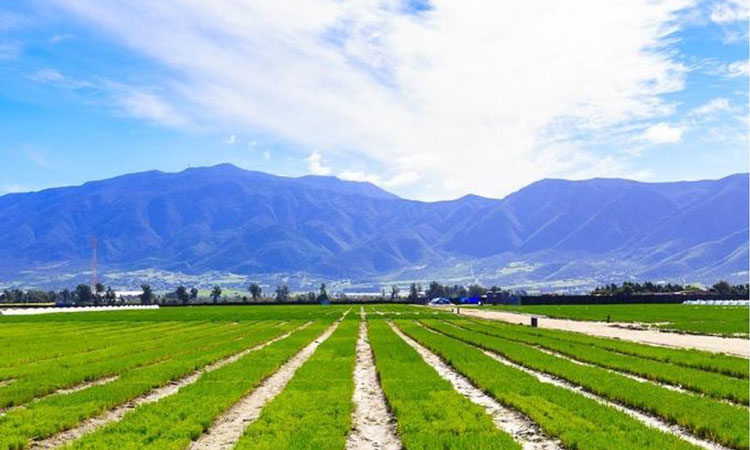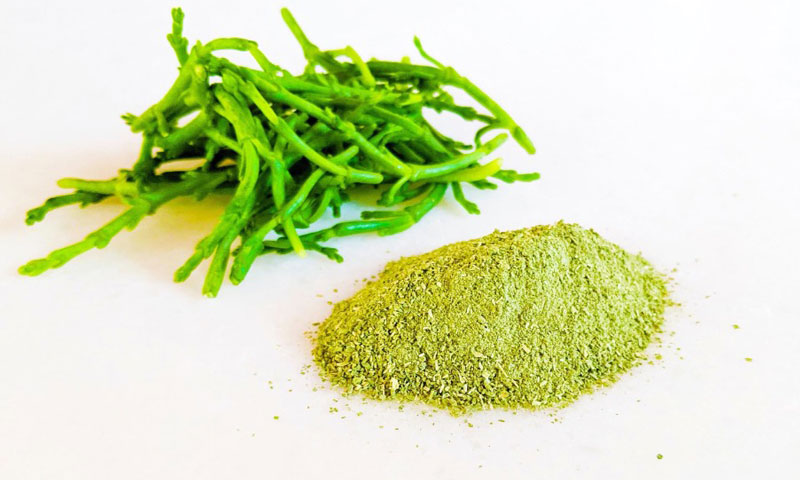Green Salt – a healthy salt alternative?
- Like
- Digg
- Del
- Tumblr
- VKontakte
- Buffer
- Love This
- Odnoklassniki
- Meneame
- Blogger
- Amazon
- Yahoo Mail
- Gmail
- AOL
- Newsvine
- HackerNews
- Evernote
- MySpace
- Mail.ru
- Viadeo
- Line
- Comments
- Yummly
- SMS
- Viber
- Telegram
- Subscribe
- Skype
- Facebook Messenger
- Kakao
- LiveJournal
- Yammer
- Edgar
- Fintel
- Mix
- Instapaper
- Copy Link
Posted: 22 April 2021 | Chris Lin | 2 comments
Chris Lin, co-founder of Green Salt LLC, explains why their eponymous product could prove to be an essential seasoning of the future – for both our taste buds and health.


Two hours south of San Diego, next to the foothills of Ensenada, Baja California, lies a neatly manicured green field. From a distance it looks like grass or maybe onion shoots, but as you get closer, you see that it’s something very different. It appears to be small sprouts of asparagus that have been painted bright green. This is salicornia – also known as sea asparagus or samphire – and the ingredient for Green Salt.
Salicornia has been harvested for millennia and used in a variety of cultures – eaten steamed and cooked in Europe and dried for folk medicine in Korea. Salicornia naturally has a salty taste and succulent texture and it belongs to the family of plants called halophytes. The plant needs salt water in order to grow and it absorbs sodium chloride and other minerals as a way of adapting to salinity. Salicornia can be found wild on the coasts of Europe and Asia, but here in Baja California our operation was the first in the world to grow the plant commercially and we remain one of the few farms that does so today.


Green Salt, made from ground dehydrated salicornia
Today, fresh salicornia is used in fine dining restaurants the world over, as chefs appreciate how its salty taste complements seafood. On our farm, we’ve been growing and selling fresh salicornia to restaurants in Europe and North America for more than a decade, but in order to reduce crop waste, we also dehydrate the product, which extends its shelf life by two-three years.
In doing so we’ve discovered that dehydrated ground salicornia can be used as a healthy substitute for salt. This green powder, or Green Salt, has 50 percent less sodium than salt, contains 11 percent protein, 20 percent fibre, and vitamins and minerals such as zinc, potassium, and vitamin B3. These mineral and nutrient analyses were carried out by labs in California, Mexico, Germany and Korea.
However, Green Salt is not only salty, it also adds an umami taste to food as well, making vegetables especially delicious. Furthermore, not only does Green Salt have a balanced nutritional profile, but it’s also been demonstrated to have antihypertensive properties. A study carried out by Zhang and others in 20151 compared sodium chloride derived from salicornia and sodium chloride derived from common table salt. When fed to rats, sodium chloride from common salt caused high blood pressure, however, when fed a salicornia-based diet with the same percentage of sodium chloride, the rats did not develop high blood pressure. This is surprising because the same percentage of sodium should have caused an equal elevation of high blood pressure. The researchers in the study think that salicornia’s other minerals (magnesium, calcium and potassium) might have a protective effect against high blood pressure and the deleterious effects of sodium.
Green Salt and salicornia could be a much-needed solution to the world’s high blood pressure crisis. According to the American Heart Association, 45 percent of US adults have high blood pressure and the World Health Organization says that 1.3 billion people suffer the affliction worldwide. High blood pressure dramatically increases our chances of death by stroke and heart disease. If we can reduce high blood pressure numbers, we can reduce global fatalities. Just a 10 percent reduction in sodium intake can prevent 500,000 strokes.2
References
- Zhang S, Wei M, Cao C, Ju Y, Deng Y, Ye T, Xia Z, Chen M. 2015. Effect and mechanism of Salicornia bigelovii Torr plant salt on blood pressure in SD rats. Food Funct 6(3): 920– 6.
- Smith-Spangler CM, Juusola JL, Enns EA, Owens DK, Garber AM. 2010. Population strategies to decrease sodium intake and the burden of cardiovascular disease: a cost-effectiveness analysis. Ann Intern Med 152(8):481–7.
About the author
Chris Lin is the co-founder of Green Salt LLC. At Green Salt, our team of agricultural engineers helped develop a healthy alternative to salt using salicornia, a halophyte plant. With Green Salt, we hope to improve the cardiovascular health of the general population by lowering sodium intake and preventing incidence of hypertension.
Related topics
Flavours & colours, Health & Nutrition, Ingredients, New product development (NPD), Plant based










It would be nice to see this salt available in larger grain sizes rather than powder, much like kosher salt flakes or coarse ground salt.
For people with advanced kidney disease, both the amount of potassium and the amount of sodium is important. Is there a way for Green Salt users to monitor how much of each they are ingesting when they use it?